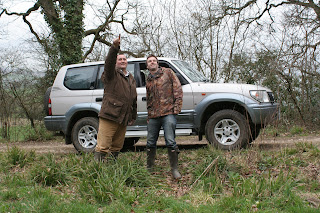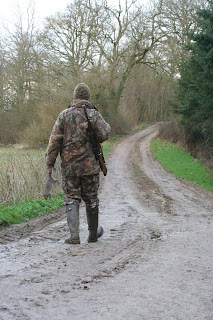Readers of Airgun Shooter magazine will have seen my recent head-to-head test of three alternatives to conventional lamping/night vision kit. The test was my first encounter with the The NiteSite NS50 - a gadget that has caused quite a stir since its recent launch. I was very impressed, both in terms of price and performance, so I thought I'd include a version of the review here.
The NiteSite NS 50 is one of the most impressive night shooting gadgets I have ever used. This ingenious system provides the benefits of Night Vision hunting without the hassle of having to change scopes and re-zero or splashing out on a dedicated NV combo.
Although I have dedicated Night Vision optics of my own, I hardly ever use them because they’re heavy, cumbersome and can’t compete with the precision of a conventional telescopic sight. But with the NiteSite, you get to enjoy the performance of your usual daytime scope along with the stealth of NV.
The NiteSite works by fitting an infra-red (IR) camera onto your scope’s eyepiece, which then relays the sight picture to a monitor mounted on top of the scope. The image on the monitor, which includes your scope’s crosshairs, then acts as your sighting device.
Packaged in a tough, foam-lined plastic case, the NiteSite kit includes the nifty little camera, the monitor (which has a three-inch LCD screen) and battery pack – plus cables for fitting all three together. The package also includes battery charging gear, quick-fit adaptors to fix the monitor to the top of your scope (to fit one-inch and 30mm tubes) and two eyepiece adaptors that will connect the camera to the eyepiece of most scopes.
One of the most impressive things about this system is how easy it is to use and how quickly you can fit it to your daytime hunting combo and take it off again. To get up and running, all you do is fit the correct-sized clamp to your scope tube and then slide the fixture at the base of the screen into it – making sure it’s facing you – and then tighten the clamp. Next, you push the eyepiece adaptor tube over the rear lens of your scope, pop the camera into it, ensuring that it’s fitted centrally, connect the cables and switch on. It only takes a moment.
You can fine-tune the picture on the monitor by adjusting the eyepiece connector to ensure perfect ‘eye relief’ to the camera. And, if the crosshairs appear blurry, you can focus the lens by making quarter turns with your finger. This focusing won’t need to be repeated if you stick with the same scope.
The NiteSite is switched on by turning the switch on the top of the monitor module. On the opposite side from the screen is an infra-red illuminator, with a selection of power levels that you can turn up or down with a twist of the switch. The first switch-on was a revelation for me – sat in the house with the lights switched off, the NS50 produced probably the sharpest NV image I have ever seen. I couldn’t wait to get it out in the field.
The camera and monitor/illuminator modules are comparatively light - lighter than most NV units - but the battery pack is a hefty one. It weighs-in at around 1.5 kilos and you certainly know when you’ve got it strapped over your shoulder, or stuffed in a large pocket of your shooting jacket. However, that chunky battery pack holds enough power for more than five hours of continual use. It then takes six hours to recharge when flat.
Although the battery is bulky, it doesn’t really affect the performance of the NS50. The head-up shooting position required to view the monitor will affect your marksmanship, though. I found that, without the usual contact with the cheek-piece, standing shots were tricky, although ‘kneelers’ could be taken after taking time to familiarise myself with the new setup.
The NS50 really excels when used from a rested position, and is perfect for static ratting; when you can sit and use crates, pallets, sacks or strawbales to support the gun. During the test period, I used the NiteSite to tackle rats that were targeting the chicken run in my garden. Sat at a table, with the gun mounted on a bipod, the NS50 made easy work of 15-metre to 20-metre targets. At this range, I only used the built-in IR illuminators at their lowest two levels and the picture on the screen was incredibly sharp – so sharp that I could watch small spiders clambering about on a stack of logs some 20 metres away.
I reckon the NiteSite would be an awesome tool for sniping rabbits with a bipod mounted gun, when it’s dry enough to sprawl out on the grass during the warmer months. Using the IR illuminators at the higher power levels certainly produces an acceptable sight picture at the manufacturer’s stated 50 metres and beyond.
With no conventional light-source, the NiteSite provides concealment on a par with dedicated NV optics. The only compromise is the fact that light from the screen does illuminate the shooter’s face, although only to a negligible degree.
The NiteSite NS50 package retails for £399; not cheap but I reckon it represents great value for money. Its big brother, the NS-200, costs £599 and is suitable for use out to 200 metres.
To find out more, see
www.nitesite.co.uk



















